At the Administrative Appeals Tribunal (AAT), we give individuals and organisations the opportunity to have administrative decisions independently reviewed. We review decisions made by Australian Government ministers, departments and agencies and, in limited circumstances, decisions made by state and territory government and some non-government bodies.
The types of decisions the AAT most commonly reviews relate to:
- Australian citizenship
- child support
- family assistance and social security
- migration and refugee visas
- the National Disability Insurance Scheme
- taxation
- veterans’ entitlements
- workers’ compensation under Commonwealth laws.
We also review a wide range of other decisions, including decisions about aged care, bankruptcy, child care services, civil aviation, corporations and financial services regulation, customs, education regulation, freedom of information, paid parental leave, passports, professional regulation, security assessments by the Australian Security Intelligence Organisation and unpaid employment entitlements. We can only review a decision if a law states that the decision can be reviewed by the AAT.
We aim to make our review processes accessible, fair, just, economical, informal, quick and proportionate.
We manage our workload in 9 divisions:
- Freedom of Information (FOI) Division
- General Division
- Migration and Refugee Division
- National Disability Insurance Scheme (NDIS) Division
- Security Division
- Small Business Taxation Division
- Social Services and Child Support Division
- Taxation and Commercial Division
- Veterans’ Appeals Division.
The AAT is led by President Justice David Thomas, a judge of the Federal Court of Australia and also consists of other members appointed as Deputy Presidents, Senior Members and Members. The President is responsible for the overall management of the AAT with the assistance of the Deputy Presidents appointed as Division Heads and the Registrar, Sian Leathem.
We also host the Immigration Assessment Authority (IAA), a separate office within the Migration and Refugee Division, which provides a fast track review process in relation to certain decisions to refuse protection (refugee) visas.
AAT key caseload statistics
The AAT received 37,483 applications in 2020–21, 31% fewer than the number lodged in 2019–20, and the lowest number of applications lodged since our amalgamation in 2015. We finalised 44,565 applications, 14% fewer than in 2019–20, which was a year in which finalisations reached the highest levels since amalgamation.
As the number of applications finalised was greater than the number lodged, leading to a 119% clearance rate, the number of applications on hand at 30 June 2020 was 10% fewer than the previous year, at 65,374.
AAT caseload overview, 2016–17 to 2020–21
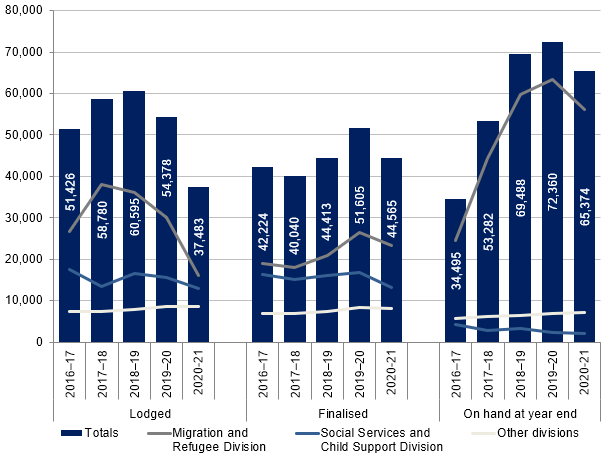
The size of our caseload varies significantly between divisions. Almost 90% of the applications made in 2020–21 were in the Migration and Refugee Division, the Social Services and Child Support Division and the General Division. The NDIS Division comprises a small but steadily increasing proportion of the overall caseload: 2% in 2018–19, 3% in 2019–20 and 6% in 2020–21. A combined 4% of applications were in the FOI, Security, Small Business Taxation, Taxation and Commercial, and Veterans’ Appeals Divisions.
Applications lodged, finalised and on hand, 2020–21 – By division
|
DIVISION
|
LODGED
|
FINALISED
|
ON HAND AT YEAR END
|
|
No
|
% of total
|
No
|
% of total
|
No
|
% of total
|
|
Freedom of Information
|
78
|
<1%
|
47
|
<1%
|
110
|
<1%
|
|
General
|
4,775
|
13%
|
5,208
|
12%
|
3,558
|
5%
|
|
Migration and Refugee
|
15,969
|
43%
|
23,246
|
52%
|
56,036
|
86%
|
|
National Disability Insurance Scheme
|
2,160
|
6%
|
1,448
|
3%
|
1,631
|
2%
|
|
Security
|
21
|
<1%
|
3
|
<1%
|
27
|
<1%
|
|
Small Business Taxation
|
552
|
1%
|
418
|
<1%
|
453
|
<1%
|
|
Social Services and Child Support
|
13,013
|
35%
|
13,088
|
29%
|
2,186
|
3%
|
|
Taxation and Commercial
|
718
|
2%
|
897
|
2%
|
1,151
|
2%
|
|
Veterans’
Appeals
|
197
|
<1%
|
210
|
<1%
|
222
|
<1%
|
|
TOTAL
|
37,483
|
100%
|
44,565
|
100%
|
65,374
|
100%
|
Our review processes vary according to the type of decision being reviewed, reflecting differences in legislative requirements as well as specific approaches we have developed to deal with the broad range of decisions we review.
We use alternative dispute resolution (ADR) in many types of cases in the FOI, General, NDIS, Small Business Taxation, Taxation and Commercial, and Veterans’ Appeals Divisions to help parties understand and narrow the issues in dispute, identify further evidence that will be gathered, and try to reach agreement about how their case should be resolved.
The successful use of ADR processes continued during COVID-19 restrictions with events previously conducted in person being run by telephone and video instead. Overall, an ADR event was held in 4,299 matters in 2020–21 which is around 90 more matters than in 2019–20.
Applications to the AAT may be finalised in different ways. This reporting year, we finalised the majority of applications by making a decision on the review, usually after conducting a hearing. The application was finalised ‘by consent’ in 8% of cases with the AAT making a decision in accordance with terms of agreement reached by the parties. The remaining 31% of applications were withdrawn, finalised on the basis that they did not meet the requirements for a valid application, or otherwise dismissed without the Tribunal reviewing the decision. The AAT changed the decision under review in 29% of all applications finalised in 2020–21, an increase of 3% on the previous year.
Mode of finalisation of applications for review of decisions, 2020–21a
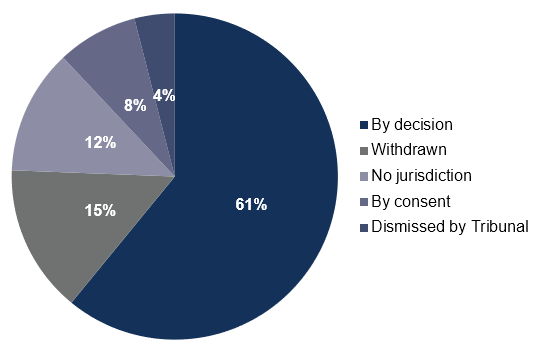
a ‘By decision’ includes applications finalised by a decision of the AAT on the merits under section 43 of the Administrative Appeals Tribunal Act or section 349 or 415 of the Migration Act. ‘No jurisdiction’ includes applications in relation to which the AAT cannot review the decision. ‘By consent’ includes applications finalised in accordance with terms of agreement reached by the parties.
Outcomes of applications for review of decisions, 2020–21b
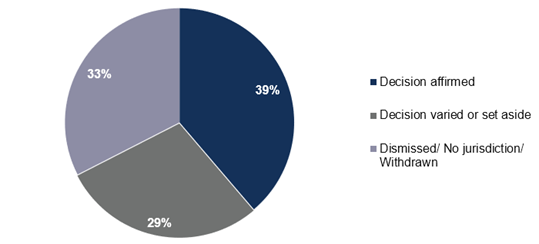
a Percentages may not total 100% due to rounding
IAA key caseload statistics
The IAA received 894 referrals in 2020–21, a 49% decrease compared with the previous year. This reduction in referrals was a result of the impacts of COVID-19.
The IAA finalised 788 cases in 2020–21. During the reporting period, the IAA maintained the median 5 weeks from referral to decision as was reported for the previous year. In most cases, the IAA affirmed the decision under review (717 cases), with the decision remitted to the Department of Immigration for reconsideration in 55 cases. Sixteen cases were finalised on the basis that they were referred to the IAA in error.
|
|
REFERRALS
|
FINALISATIONS
|
ON HAND AT YEAR END
|
MEDIAN TIME TO FINALISE (WEEKS)
|
|
2019–20
|
1,745
|
1,731
|
106
|
5
|
|
2020–21
|
894
|
788
|
212
|
5
|
The top 5 countries of reference of referred applicants in 2019–20 were Sri Lanka, Iran, Pakistan, Bangladesh and Afghanistan. Sri Lanka remained the largest single source country of referrals overall and increased its proportion of the IAA’s caseload. Referrals from Iran also increased proportionately, while the number of referrals from Pakistan decreased during this period.
IAA referrals by country of reference, 2020–21
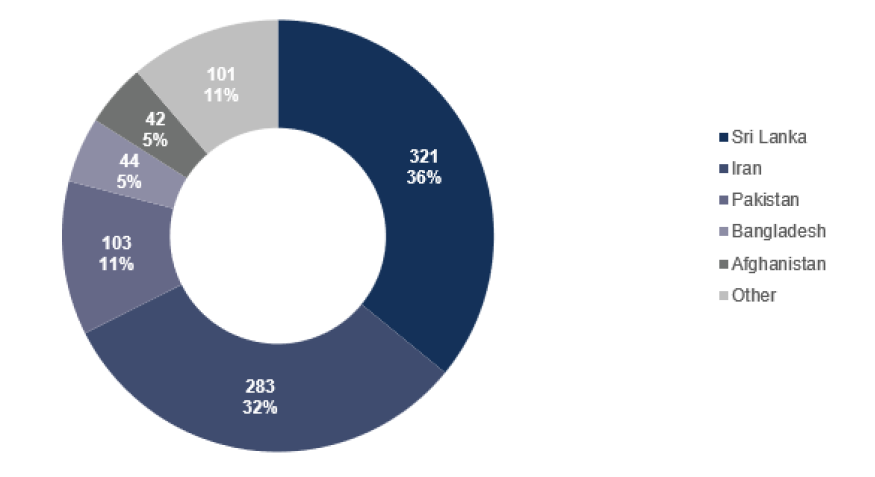
Our performance
Number of finalisations
The number of cases finalised is an indicator of the scale of activity undertaken by the AAT and IAA in carrying out our role of reviewing decisions that affect the interests of individuals and organisations. In 2020–21, we finalised a substantial number of applications and referrals, and reached 84% of our target, notwithstanding the ongoing challenges associated with the COVID-19 pandemic.

Clearance ratio
The clearance ratio is a measure of how many AAT applications and IAA referrals were finalised in the reporting year in relation to how many were received. In 2020-21, we well exceeded the target for this measure. We received 38,377 applications and referrals and finalised 45,353 applications and referrals, giving a clearance ratio of 118%. As a result, the total number of cases on hand at 30 June 2021 (65,586) was 9% lower than at 30 June 2020.

Timeliness
This measure is an indicator of the extent to which the AAT and IAA are providing a mechanism for a review that is quick. In 2020–21, we fell short of our overall target of finalising 75% of cases within 12 months of lodgement for a third consecutive year. While we met the benchmark in the AAT’s NDIS, Small Business Taxation, and Social Services and Child Support Divisions, as well as in the IAA, timeliness declined further in the Migration and Refugee Division which accounted for just over half of the AAT’s finalisations in the reporting period. The volume of applications in that Division has increased significantly over recent years without a corresponding increase in the number of members and staff to deal with the larger workload. This situation is likely to continue while we work through the backlog of cases in this Division.
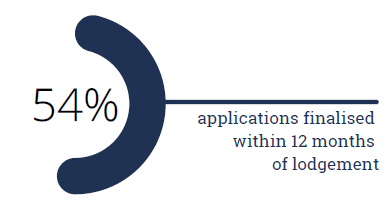
Publication of decisions
We publish statements of reasons for decisions we make in accordance with our Publication of Decisions Policy to promote public trust and confidence in our decision-making. We well exceeded our 2020–21 target to publish at least 5,000 decisions, with 5,860 decisions published at the time of preparing our Annual Report. Our decisions can be found on the Australasian Legal Information Institute website (www.austlii.edu.au).

User experience rating

We seek feedback from parties and representatives about the quality of our services by conducting an online survey administered by an independent organisation. We ask our users for their views on a range of matters, including the process of applying for a review, the information we provide, dealings with staff, the experience of conferences and hearings, as well as perceptions of the process overall. The result for the survey conducted in 2020–21 exceeded our target of a rating of at least 70% and gave our highest score since we began reporting on the measure in 2019. Overall, both parties and representatives continued to rate our services positively.
Judicial review outcomes
Some decisions made by the AAT and IAA may be appealed to the courts. An appeal may be allowed if there has been an error of law in relation to how the review was conducted or in reaching a decision. We aim to have fewer than 5% of appeals against our appealable decisions allowed by the courts. In 2020-21, 617 appeals of decisions made by the AAT and IAA were allowed, which was 2.3% of all appealable decisions from the previous year and well under target.
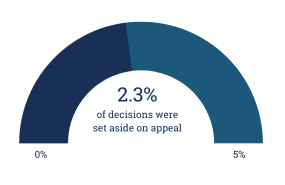
Key achievements in 2020–21
Throughout the year the AAT remained focused on providing high-quality merits review, while continuing to respond to the impacts of the COVID-19 pandemic. Following an initial period of adjustment, our attention in this reporting year moved to reviewing and refining our processes and systems to take advantage of the benefits that arose with a changed operating model. Our improved user experience rating indicates that parties and representatives have had a positive experience while we have increased the proportion of our remote activities.
We were able to finalise a significant number of cases during the reporting year, even when access to our registries was restricted. This was due to our adapted processes and systems for progressing cases. A decline in lodgements allowed us to make modest inroads into our backlog of cases, however, we continue to engage with Government about the resourcing needed to substantially reduce our significant on-hand caseload.
To support more flexible and accessible methods of conducting and participating in hearings and other case events, we launched a hearing enablement project during the reporting year. This involves reviewing our infrastructure to identify opportunities to further integrate technology and make better use of existing spaces. As part of this project, we are also designing and testing a multi-purpose hearing room with enhanced accessibility features.
The AAT’s new unified online services portal went live in 2020–21, making it simpler for people to interact with us electronically. Through the portal, users can apply for a review and upload documents for any type of case. If they choose, they can create an account and review the details of applications they have made or documents they have lodged. For some types of cases, the portal provides additional information, including past and future case events.
We undertook work to improve the accessibility of our services, including translating some of our fact sheets into frequently used languages, and conducting tailored outreach to parties to support remote hearing processes. We also commenced trialling increased use of video hearings in the Social Services and Child Support Division.
To complement our annual post-finalisation user feedback survey, we trialled a new survey of parties participating in alternative dispute resolution, conducted immediately following a case event, for more proximate feedback. The survey produced useful data and will inform how we seek feedback in the future.
In relation to technology, we built on changes made in 2019–20 to enable more mobile ways of working. We deployed new devices to our members and staff, installed wi-fi in all of our premises and enhanced the ability of members and staff to access AAT systems remotely. We also strengthened our cyber security arrangements and capabilities.
Our critical project to develop a single case management solution for the AAT worked through the discovery phase in 2020–21. We are well placed to make milestone design decisions as the project continues into 2021–22.
During 2020–21 we worked with Government to progress legislative reforms which aim to reduce inconsistencies in the powers and procedures across our divisions. This harmonisation is supported by the recommendation from the statutory review of the amalgamated AAT conducted by the Hon Ian Callinan AC in 2018. The Courts and Tribunals Legislation Amendment (2021 Measures No.1) Bill 2021 was introduced into Parliament in June 2021. It proposes a range of amendments, including changes applying to reviews in the Social Services and Child Support Division, designed to enhance consistency and improve our flexibility to tailor procedures to suit different cases.
Recognising that our people are fundamental to the delivery of high-quality merits review, in 2020–21 continued to work towards ensuring our organisation has a positive culture, our people have the right capabilities and our workplace arrangements are fit for purpose. We again offered a diverse range of internal and external professional development opportunities with expanded access to online learning options. With many members and staff having rapidly transitioned to working from home during the pandemic, we reviewed our changed working arrangements and identified what we learnt, to inform how we will work in the future. We published revised working from home policies and procedures, which offer increased flexibility and formalise arrangements for working regularly from home.
More detailed information about the AAT and our operations can be found in our 2020–21 Annual Report, available on our website (www.aat.gov.au) and on the Australian Government Transparency Portal (www.transparency.gov.au).